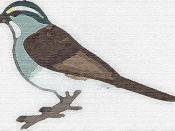In a world bereft of love, who is there to look to for consolation? Above us all looms a presence far greater than our realm of comprehension, but is He accountable for all? Religion has been believed by many a person throughout history, but all can not count on faith being there during times of need. In "The Sparrow," by Dr. Gardner, the author uses language and symbols to create a theme of lost hope in religion. With situations in time changing, we must move past looking for simple answers to complex questions in religion, and start looking for the answers within ourselves. If fallen, faith will not save you.
The poem opens amidst the perspective of a third person. When the author says, "Here is one that escaped His eye/ He lies prone on the cold earth," (Stanza 1, lines 1,2) a feeling of remorse is created, pitying the poor creature that has been left behind.
The third person perspective initiates this sadness as the reader looks down upon the susceptible sparrow from a distance. The author uses this distance to his advantage in order to create a burning question... If the reader can see the sparrow suffering, why can't the almighty "He" (Stanza 1, line 2) see it and lend help? Although the reader's heart can tell the creature is in peril, this vantage point also suggests how insignificant the sparrow actually is, and it is here that the reader realizes that God will not help all.
Entering the third stanza, the author writes, "I would inter you in the thankless/ earth, but here I leave you" (Stanza 3, lines 1,2). Now we have an immediate shift to the first person, suggesting a possible answer to the burning question, "why?" The reader learns from the first person perspective of "He" that God "would" (Stanza 3, line 1) put the sparrows body to rest,however "here" (Stanza 3, line 2) the sparrow is left to die with "broken wing," (Stanza 3, line 3) because it is not worth God's effort to save, or put it to peaceful rest. Also, the symbol of a broken wing is used by the author to further the understanding of the sparrow's submissive condition. In this first person answer, the reader witnesses the brutality of God. The reader may see the sparrow, "bleak on paling white" (Stanza 1, line 5) and want to assist it, however He does not want to give the time. The symbolic nature of a bleak half-dead corpse blending in to a white background also shows how the sparrow may simply be over-looked. By exemplifying this image, the author etches into the readers mind, the hopelessness of those who have lost hope.
Through these presented perspectives and symbols, we learn that the author sees nothing in religion and suggests that if one is to succeed, he/she must help himself/herself. One with heart may gaze upon the wounded wanting to save them, but it is beyond their power to do so. God, enchanted with unlimited power has the opportunity but allows the insignificant to go the "way of death" (Stanza 3, line 5). The theme of religion being hopeless is evident in the authors writing. The moral here suggests that one must not listen "for the word" (Stanza 2, line 8) of another or higher power to help. Only you can save yourself.
BibliographyGardner, Donald. The Sparrow. 1st. New York: 1990. Print.




